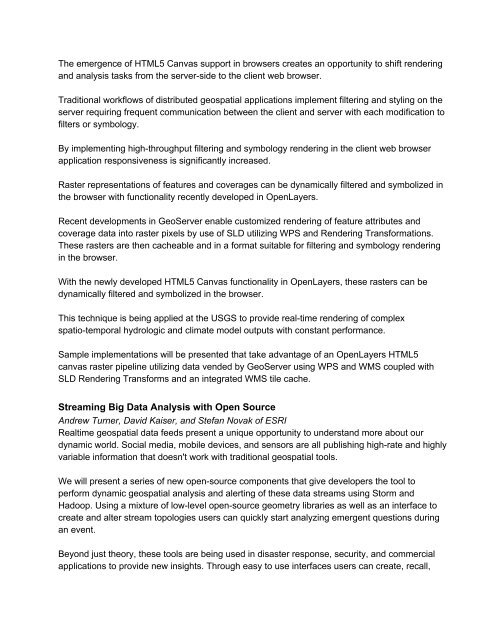FOSS4G North America Conference 2013 Preliminary Program
FOSS4G North America Conference 2013 Preliminary Program
FOSS4G North America Conference 2013 Preliminary Program
Create successful ePaper yourself
Turn your PDF publications into a flip-book with our unique Google optimized e-Paper software.
The emergence of HTML5 Canvas support in browsers creates an opportunity to shift rendering<br />
and analysis tasks from the serverside to the client web browser.<br />
Traditional workflows of distributed geospatial applications implement filtering and styling on the<br />
server requiring frequent communication between the client and server with each modification to<br />
filters or symbology.<br />
By implementing highthroughput filtering and symbology rendering in the client web browser<br />
application responsiveness is significantly increased.<br />
Raster representations of features and coverages can be dynamically filtered and symbolized in<br />
the browser with functionality recently developed in OpenLayers.<br />
Recent developments in GeoServer enable customized rendering of feature attributes and<br />
coverage data into raster pixels by use of SLD utilizing WPS and Rendering Transformations.<br />
These rasters are then cacheable and in a format suitable for filtering and symbology rendering<br />
in the browser.<br />
With the newly developed HTML5 Canvas functionality in OpenLayers, these rasters can be<br />
dynamically filtered and symbolized in the browser.<br />
This technique is being applied at the USGS to provide realtime rendering of complex<br />
spatiotemporal hydrologic and climate model outputs with constant performance.<br />
Sample implementations will be presented that take advantage of an OpenLayers HTML5<br />
canvas raster pipeline utilizing data vended by GeoServer using WPS and WMS coupled with<br />
SLD Rendering Transforms and an integrated WMS tile cache.<br />
Streaming Big Data Analysis with Open Source<br />
Andrew Turner, David Kaiser, and Stefan Novak of ESRI<br />
Realtime geospatial data feeds present a unique opportunity to understand more about our<br />
dynamic world. Social media, mobile devices, and sensors are all publishing highrate and highly<br />
variable information that doesn't work with traditional geospatial tools.<br />
We will present a series of new opensource components that give developers the tool to<br />
perform dynamic geospatial analysis and alerting of these data streams using Storm and<br />
Hadoop. Using a mixture of lowlevel opensource geometry libraries as well as an interface to<br />
create and alter stream topologies users can quickly start analyzing emergent questions during<br />
an event.<br />
Beyond just theory, these tools are being used in disaster response, security, and commercial<br />
applications to provide new insights. Through easy to use interfaces users can create, recall,


